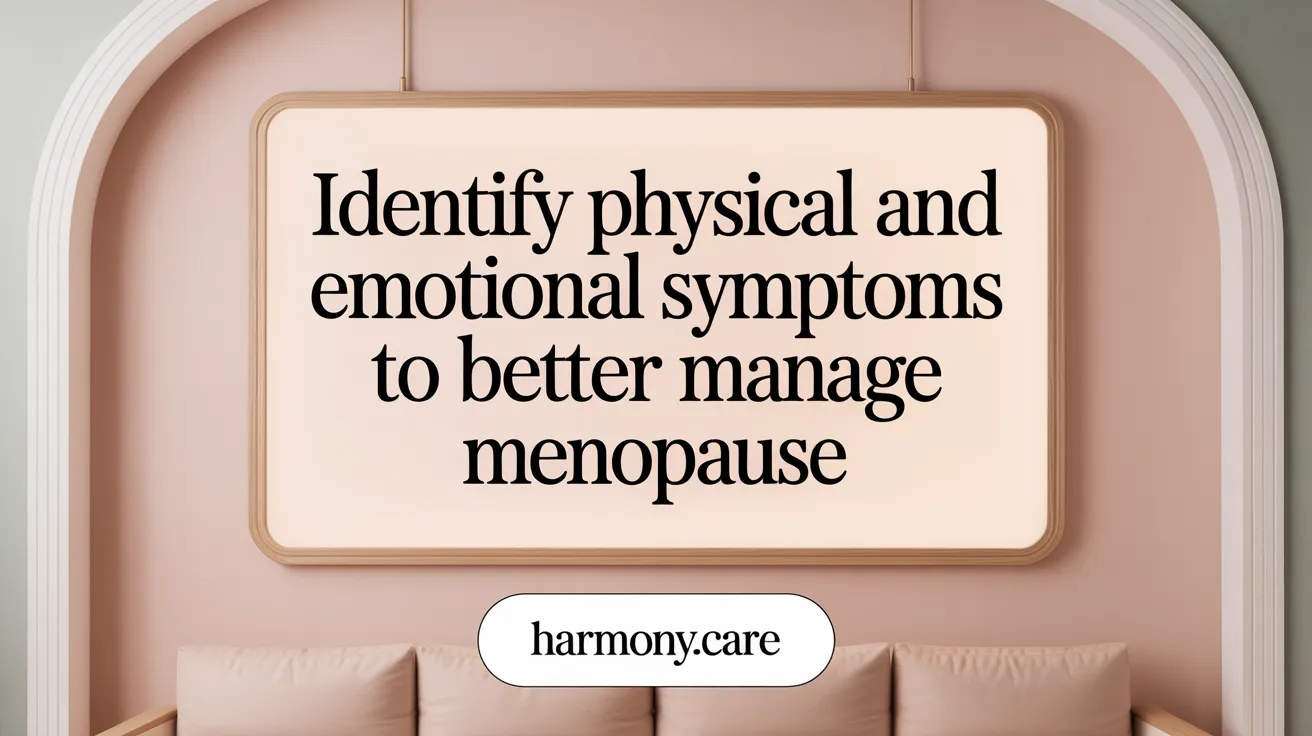Understanding Menopause: A Natural Transition
Menopause is a significant biological milestone in a woman's life, defining the end of reproductive years typically occurring between ages 45 and 55. Characterized by the cessation of menstrual periods for twelve consecutive months, menopause is preceded by perimenopause—a phase marked by fluctuating and ultimately declining estrogen and progesterone levels. These hormonal changes give rise to a wide variety of symptoms such as hot flashes, night sweats, mood swings, sleep disturbances, vaginal dryness, and increased risks of osteoporosis and cardiovascular disease. Recognizing menopause as a natural aging process rather than a disease opens the door to integrative strategies that combine medical, lifestyle, and complementary approaches to enhance symptom management and overall quality of life.
Stages and Symptoms: Navigating the Menopausal Journey

What is Menopause and What Are Its Stages?
Menopause is the natural biological transition marked by the end of menstrual periods, diagnosed after 12 consecutive months without menstruation. The average age for menopause is around 51 to 52 years, though it can vary. Learn more about the Menopause age range and Definition of menopause.
Menopause unfolds in three main stages:
- Perimenopause: Begins 4-10 years before menopause, usually in a woman's 40s, characterized by hormonal fluctuations that cause irregular periods and symptoms. Explore details on the Perimenopause phase
- Menopause: The point when menstrual periods have ceased for a year, signaling the end of reproductive years. Read about Menopause diagnosis after 12 months without a period.
- Postmenopause: The phase following menopause, when symptoms may ease but risks like osteoporosis and cardiovascular disease increase. Understand more on Postmenopause symptoms and health risks.
There is also premature menopause, occurring before age 40, often linked to primary ovarian insufficiency. See Premature menopause causes and age for further information.
What Physical and Emotional Symptoms Are Common?
Hormonal declines primarily in estrogen and progesterone during perimenopause and menopause cause various symptoms:
- Physical Symptoms: Hot flashes, night sweats, vaginal dryness, painful intercourse, irregular or stopped periods, sleep disturbances, weight gain, dry skin, thinning hair, joint pain, urinary symptoms, and bone density loss. Find out about Menopause symptoms and Physical changes during menopause.
- Emotional Symptoms: Mood swings, irritability, anxiety, depression, brain fog, and memory issues are frequent and may affect quality of life. Review Emotional health in menopause and Managing mood swings in menopause.
Women often experience changes in sexual health such as reduced libido and discomfort, alongside physical aging signs. Explore Menopause and sexual health and Vaginal dryness treatments.
How Are Hormonal Changes Diagnosed?
Hormonal shifts include decreased estrogen and progesterone, fluctuating follicle-stimulating hormone (FSH), and variations in inhibin and anti-Müllerian hormone (AMH). Diagnosis mainly relies on clinical history — specifically 12 months without a period. Learn about Menopause diagnosis and diagnosing menopause with blood tests.
Blood tests measuring FSH, estradiol (estrogen), and thyroid-stimulating hormone (TSH) can support diagnosis but are not definitive due to hormonal variability during perimenopause. See also FSH and estradiol levels in menopause and TSH and menopause differentiation.
Understanding these changes helps guide management strategies tailored to individual symptoms and health risks. For more guidance, see Navigating menopause and Consulting healthcare providers for menopause.
Lifestyle Modifications for Symptom Relief and Health Promotion

Dietary Recommendations
A well-balanced diet plays a crucial role in managing menopausal symptoms and promoting overall health. Women are encouraged to consume calcium-rich foods like dairy products, leafy greens, tofu, beans, and sardines to support bone health and reduce osteoporosis risk. Vitamin D intake, through fatty fish, eggs, fortified foods, or supplements, also aids calcium absorption. Incorporating omega-3 fatty acids from sources such as fatty fish, walnuts, and flaxseeds supports cardiovascular health. Additionally, foods rich in phytoestrogens—plant-based estrogens found in soy, flaxseed, and sesame seeds—may help balance hormone levels and alleviate hot flashes. Emphasizing unprocessed, nutrient-dense foods, including fruits, vegetables, whole grains, nuts, and seeds, contributes to symptom relief and overall wellness.
Exercise Benefits
Regular physical activity is highly beneficial during menopause. Aerobic and resistance training exercises can reduce the frequency and intensity of hot flashes, improve sleep quality, enhance mood, support bone density, and maintain lean muscle mass. Weight-bearing activities specifically help prevent bone loss, while exercises like yoga and tai chi promote relaxation and stress reduction. Maintaining a moderate, healthy weight through consistent exercise can also diminish vasomotor symptoms such as night sweats.
Hydration and Sleep Hygiene
Staying well-hydrated is important to alleviate vaginal dryness and bloating common during menopause. Drinking adequate water supports hormonal balance and overall health. Sleep hygiene practices—including keeping consistent sleep schedules, avoiding caffeine and alcohol before bedtime, and maintaining a cool sleeping environment—can help reduce sleep disturbances caused by hot flashes and night sweats.
Avoiding Symptom Triggers
Certain foods and lifestyle factors can aggravate menopausal symptoms. Women are advised to limit or avoid spicy foods, caffeine, alcohol, and sugary or ultra-processed foods to minimize hot flashes and night sweats. Dressing in breathable clothing and using fans or cold drinks helps manage sudden heat sensations. Smoking cessation and limiting alcohol intake further enhance symptom control and overall health.
Stress Management
Stress can worsen menopausal symptoms by disrupting hormonal balance. Incorporating stress reduction techniques—such as mindfulness meditation, deep breathing exercises, yoga, tai chi, and cognitive behavioral therapy—supports emotional well-being and may reduce symptom severity. Maintaining social connectivity and seeking counseling when needed further contribute to a smoother menopausal transition.
Hormone Replacement Therapy: Benefits, Risks, and Personalization

What are the uses and effectiveness of Hormone Replacement Therapy (HRT)?
Hormone Replacement Therapy is widely used to alleviate menopausal symptoms such as hot flashes, night sweats, vaginal dryness, and mood swings. It can also help prevent bone density loss, reducing the risk of osteoporosis fractures. Women who begin HRT within 10 years of menopause onset or under age 60 tend to experience the most benefit, with improved sleep quality, mood, and possibly lower risk of heart disease.
When is HRT suitable and how is timing important?
HRT is particularly effective when started near the onset of menopause. Early initiation aligns with a "window of opportunity" that maximizes symptom relief and health benefits. However, treatment suitability varies depending on individual health status, age, and risk factors. Women with hormone-sensitive cancers, blood clotting disorders, or those above 60 may not be ideal candidates.
What are the potential risks and side effects?
Long-term use of HRT can increase risks of breast cancer, stroke, blood clots, and heart disease. Side effects may include gastrointestinal discomfort and rare complications depending on individual susceptibility. Vaginal estrogen, used locally, often has fewer systemic risks and effectively manages vaginal dryness and urogenital symptoms.
What about bioidentical hormones and regulation?
Biodentical hormones are often promoted as natural and safer but are not strictly regulated by the FDA. Unlike approved hormone therapies, compounded bioidentical hormones lack conclusive evidence on their safety and efficacy. Standard, FDA-approved hormone therapies provide regulated dosing and consistent quality, making them a safer choice.
Personalized treatment plans, developed with healthcare providers, that consider the timing, patient's health profile, and preferences, optimize symptom management while minimizing risk during menopause.
Complementary and Alternative Therapies: Integrative Options Beyond HRT

Herbal Supplements: Effectiveness and Precautions
Many women seek herbal supplements such as black cohosh, red clover, and soy isoflavones to relieve menopause symptoms like hot flashes and vaginal dryness. While some studies report these plant-based remedies may help balance hormones and reduce mild symptoms, scientific evidence remains mixed. Certain herbs, including black cohosh and St. John's Wort, carry risks like gastrointestinal issues or interactions with medications, underscoring the need for cautious use.
Mind-Body Practices to Support Symptom Management
Yoga, meditation, acupuncture, and breathing exercises offer non-invasive options to ease menopausal symptoms. These therapies can reduce stress, improve mood, enhance sleep quality, and even moderate hot flash severity. Acupuncture, in particular, may improve blood flow and hormonal balance, although more research is needed for definitive conclusions.
Non-Hormonal Medications and Emerging Treatments
For women unable or unwilling to use hormone therapy, FDA-approved non-hormonal drugs such as SSRIs, SNRIs, gabapentin, and novel agents like fezolinetant provide alternative symptom relief. These medications can target hot flashes and mood disturbances effectively. Emerging treatments like vaginal estrogen formulations and medications for bone health contribute to comprehensive symptom management.
Consulting Healthcare Providers is Crucial
Given the variety of options and variable evidence for complementary therapies, women are encouraged to consult healthcare providers before starting any supplement or alternative treatment. Professional guidance ensures safe use, avoids harmful interactions, and allows personalized care tailored to individual health needs during menopause.
Bone and Cardiovascular Health: Preventive Strategies During and After Menopause

What increases osteoporosis risk during menopause and how can it be managed?
Menopause leads to a decline in estrogen levels, accelerating bone density loss and increasing the risk of osteoporosis and fractures. Women can lose an average of 25% of bone mass between menopause and age 60, especially within the first 5 to 6 years (Bone density and menopause).
Managing osteoporosis risk involves:
- Ensuring adequate intake of calcium (1,000 to 1,200 mg daily) from dairy, leafy greens, tofu, beans, and sardines (Calcium and vitamin D)
- Supplementing vitamin D (600–800 IU daily) to aid calcium absorption (Calcium and vitamin D
- Engaging in regular weight-bearing and resistance exercises which help maintain and build bone density (Physical activity for bone density
- Avoiding smoking and limiting alcohol consumption (Lifestyle changes for menopause)
What cardiovascular changes occur during menopause and how can they be supported?
Declining estrogen increases risk of cardiovascular disease by affecting blood vessel function, cholesterol levels, and blood pressure. Heart disease risk rises in postmenopausal women, making cardiovascular support essential (Menopause and cardiac health.
Support strategies include:
- Eating a heart-healthy diet rich in fruits, vegetables, whole grains, and omega-3 fatty acids found in fatty fish, walnuts, and flaxseed (Dietary recommendations for menopause
- Regular aerobic exercise to improve heart function and metabolism (Exercise benefits in menopause
- Managing weight, blood pressure, and cholesterol levels (Managing menopause symptoms)
- Stress reduction techniques, such as yoga and meditation, to support vascular health (Meditation and Yoga)
What are the roles of calcium, vitamin D, and omega-3 fatty acids?
Calcium and vitamin D work together to maintain strong bones and reduce fracture risk. Insufficient vitamin D impairs calcium absorption (Calcium and vitamin D benefits.
Omega-3 fatty acids provide anti-inflammatory benefits, support heart health, and may improve menopausal symptoms. Sources include fatty fish, flaxseed, and walnuts (Omega-3 fatty acids benefits.
How does physical activity impact bone and cardiovascular health during menopause?
Physical activity benefits include:
- Strengthening bones through impact and resistance exercises to reduce osteoporosis risk (Exercise for bone health)
- Enhancing cardiovascular fitness and lowering heart disease risk (Exercise benefits for menopause
- Improving mood, sleep quality, and weight management, which collectively mitigate menopause symptoms (Managing hot flashes tips
In summary, balanced nutrition, supplementation, and consistent physical activity form the cornerstone of preventive care for bone and cardiovascular health in menopause (Balanced diet for menopause, Lifestyle changes for menopause).
Addressing Genitourinary and Sexual Health in Menopause
What are the treatment options for vaginal dryness during menopause?
Vaginal dryness is a common symptom of menopause due to declining estrogen levels. Treatment options include over-the-counter vaginal moisturizers and lubricants, which can ease discomfort during intercourse and daily activities. For more persistent symptoms, vaginal estrogen therapies—available as creams, tablets, or rings—are effective in restoring vaginal moisture and tissue health. These treatments improve comfort and reduce urinary symptoms related to genitourinary atrophy.
How does menopause affect sexual function and what aspects are commonly impacted?
Sexual dysfunction during menopause often involves decreased libido, vaginal dryness causing pain during intercourse (dyspareunia), and changes in sexual satisfaction. Hormonal changes lead to thinning and reduced elasticity of vaginal tissues, contributing to discomfort. Additionally, mood swings and decreased energy may impact sexual desire. Addressing both physical and emotional factors is important for improving sexual health, as outlined in menopause and sexual health.
What roles do vaginal estrogen therapy and lubricants play in managing menopausal symptoms?
Vaginal estrogen therapy directly targets local estrogen deficiency, effectively improving vaginal lubrication, elasticity, and reducing pain. It is considered safe for most women and typically does not require systemic hormone treatment. Lubricants provide immediate relief of dryness during sexual activity but don't address underlying tissue changes. For comprehensive care, combining both can be beneficial.
How can pelvic floor exercises support genitourinary and sexual health during menopause?
Pelvic floor exercises, such as Kegel exercises, strengthen vaginal muscles and support urinary control. They can reduce symptoms of urinary incontinence and enhance sexual function by increasing muscle tone and blood flow. Regular practice of these exercises is recommended as part of an integrative approach to managing genitourinary symptoms during menopause, as discussed in pelvic floor exercises and menopause and managing menopause lifestyle tips.
Psychological and Emotional Well-being: Managing Mood and Cognitive Changes
Mood Swings, Anxiety, and Depression
Menopause often brings significant psychological challenges. Hormonal shifts can trigger mood swings, anxiety, and depression, affecting daily life. These changes arise due to fluctuating estrogen and progesterone levels as the ovaries reduce hormone production. Women may experience irritability, sadness, or heightened emotional sensitivity.
Cognitive Symptoms Like Brain Fog
Cognitive difficulties such as brain fog — including memory lapses and trouble concentrating — are common complaints during menopause. These issues result from hormonal disruptions that impact neurotransmitters and brain function, sometimes leading to frustration and lowered confidence. Learn more about emotional health in menopause.
The Role of Cognitive Behavioral Therapy (CBT) and Hypnosis
CBT is an effective tool to manage mood swings and anxiety by helping women develop coping strategies and change negative thought patterns. Hypnosis has also shown benefits in reducing hot flash distress and improving mental well-being. Both therapies can promote better sleep and decrease emotional discomfort. More on Cognitive Behavioral Therapy for menopause.
Mindfulness and Relaxation Techniques
Practices like mindfulness meditation, deep breathing exercises, yoga, and guided relaxation help reduce stress and balance emotions. Mind-body therapies enhance mental clarity, lower anxiety, and foster a peaceful mindset.
Social Support
Connecting with peers, support groups, or counselors provides emotional validation and reduces feelings of isolation. Social engagement serves as an important buffer against depression and anxiety linked to menopause. See suggestions on stress management in menopause.
Overall, a combined approach featuring psychological therapies, relaxation methods, and social support is crucial for managing menopause-related emotional and cognitive challenges.
Empowering Women Through Education and Personalized Care
Why Is Early Recognition and Diagnosis Important?
Early awareness of menopause signs, such as irregular periods and hot flashes during perimenopause, empowers women to seek timely care. Recognizing these symptoms early can help prevent complications like osteoporosis and cardiovascular issues, allowing women to access appropriate support and treatment options sooner.
What Are Personalized Integrative Treatment Plans?
Personalized integrative care blends conventional treatments with lifestyle adaptations and complementary therapies. Tailored plans consider individual health history, symptoms, and preferences to optimize relief. These may include hormone therapy, dietary adjustments rich in calcium and vitamin D, stress management techniques like yoga and meditation, and natural supplements under medical guidance.
How Can Communication With Healthcare Providers Enhance Care?
Open dialogue with healthcare professionals is crucial for effective menopause management. Preparing questions, tracking symptoms, and discussing treatment risks and benefits enable shared decision-making. Regular consultations ensure ongoing support and modifications to care plans as needs evolve during menopause.
Why Are Support Systems and Workplace Considerations Important?
Emotional and social support improves mental well-being during menopause. Connecting with family, friends, or counseling services provides comfort. In the workplace, accommodations such as flexible hours, breathable clothing, and cool environments help manage symptoms and maintain productivity.
Through education, personalized care, and support, women can navigate menopause with confidence and improved quality of life.
Navigating Menopause with Confidence and Balance
Menopause is a multifaceted life stage that demands a compassionate, personalized, and integrative approach. By combining evidence-based medical treatments such as hormone replacement therapy with lifestyle adjustments, complementary therapies, and preventive strategies for bone and cardiovascular health, women can experience a smoother transition. Addressing not only the physical but also the emotional and sexual health aspects fosters holistic well-being. Empowering women with education, support, and personalized care enables them to embrace menopause as a natural phase of empowerment, vitality, and renewed self-awareness. Ongoing research and advances in integrative medicine continue to expand options for symptom relief and quality of life improvement, making this journey navigable with confidence and balance.
